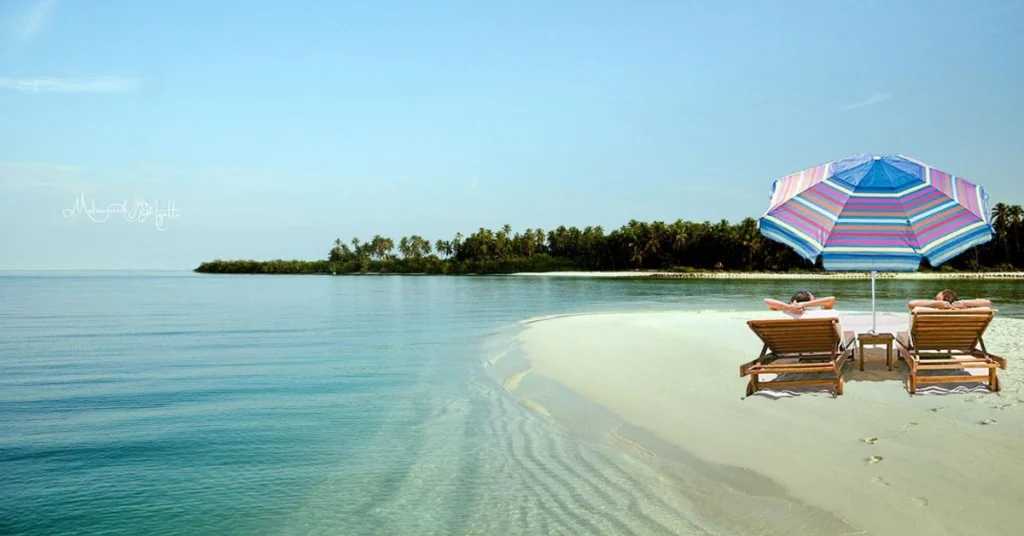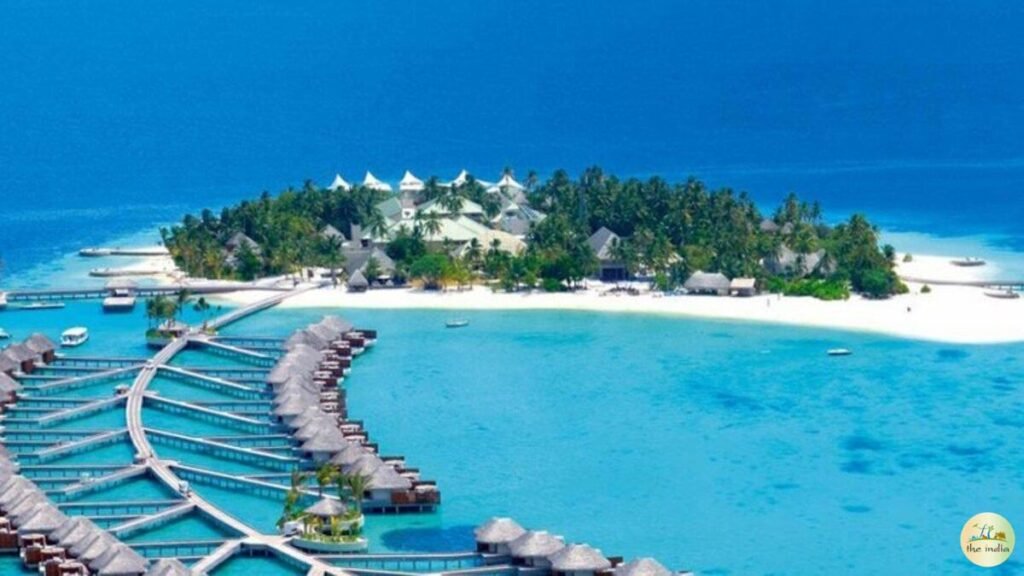Bangaram Island, famed as Lakshadweep’s “hidden gem,” is a breathtaking tropical paradise displaying dazzling white sands, stunning bioluminescent beaches, and crystal-clear lagoons. As interest in sustainable island getaways surges in 2025, Bangaram emerges as India’s answer to the Maldives, offering travelers an unmatched blend of adventure, history, and serenity.
Location and Accessibility
Bangaram is located in the Union Territory of Lakshadweep, India, approximately 459 km west from Kochi on the mainland. Its precise coordinates are 10°56′ North Latitude and 72°17′ East Longitude, with an area of about 2.3 square kilometers, making it a teardrop-shaped island surrounded by turquoise waters and coral reefs.
Reaching Bangaram typically involves a flight from Kochi to Agatti Island, Lakshadweep’s airport, followed by a 30-45 minute boat ride across shimmering lagoons. The route itself is part of the adventure, offering visitors panoramic views of the ethereal Indian Ocean.
Key Details:
History and Culture
Though Bangaram is uninhabited, its identity is closely tied to the broader, ancient heritage of Lakshadweep. The islands have been referenced in literature and travel logs since at least the 1st century CE, serving as important trading posts between South India and the outside world. Notably, Buddhist tales and Greek sailors mention these islands as valuable sources of tortoise shells and coir.
Lakshadweep’s population, and by extension, the workers and caretakers on Bangaram, reflects rich Islamic, Malayalam, and Arab cultural fusion. Over centuries, Arab traders introduced Islam, and this influence is found in local music, dance (such as “Lava” and “Kolkkali”), cuisine, and even architecture. The food is redolent of Kerala flavors, featuring spicy seafood and coconut-rich dishes such as kilanji (rice and eggs), mus kavaab (tuna), and octopus fry.
Tourism: Attractions and Activities
Why Visit Bangaram?
Bangaram is consistently named one of the world’s most beautiful getaways, with unspoiled beaches, privacy, and tranquility as its calling cards. What sets it apart in 2025 is its transformation into an eco-friendly, luxury destination with new resort developments and upgrades, many inspired by the Maldives, yet at a fraction of the travel time and cost for Indian tourists.
Key Attractions
- Bioluminescent Beaches: At night, Bangaram’s shorelines glow blue due to algae that emit light, a phenomenon called bioluminescence. Night kayaking across the glowing waters has become a signature experience for visitors in 2025.
- Snorkeling & Scuba Diving: With abundant marine life, coral gardens, and clear waters, Bangaram is a diver’s paradise. Visitors can spot seahorses, clownfish, turtles, rays, and vibrant soft corals.
- Beachfront Luxury & Eco Resorts: The latest eco-resorts offer “cocoon” and “shell” themed rooms, minimal plastic use, shared dining, and hammock-lined seaside relaxation areas.
- Water Sports: Tourists enjoy kayaking, sailing, windsurfing, and deep-sea fishing, apart from regular swimming and beach games.
- Local Cuisine: Beachside seafood dinners and authentic Lakshadweep flavors are part of the resort experience, with an emphasis on sustainability and freshness.
The Perfect Time to Visit
- July–September: Best for witnessing the magical blue plankton lights; less ideal for swimming due to monsoon waves.
- October–December: Offers the calmest seas, sunny skies, and peak conditions for water sports, snorkeling, and sunbathing.
Accommodation and Revenue Generation
Hospitality on Bangaram has seen a marked shift in 2025 with the launch of luxury, eco-friendly resorts such as those managed now by IHCL (Indian Hotels Company) and pioneering companies like Praveg Limited. Room rates range between ₹20,000 to ₹25,000 per night, targeting both local and international travellers seeking a blend of luxury and environmental consciousness.
Tourism is a main driver of revenue in Bangaram, as the Union Territory does not support extensive industry due to its size and ecosystem fragility. Visitor numbers have doubled in the past year, directly boosting income and local employment opportunities. Water sports, eco-tours, and sustainable hospitality are core to its financial model, ensuring that growth is beneficial to both the environment and the economy.

The Unique Bangaram Experience
Bangaram stands out for its commitment to privacy, no crowds, no pollution, just the soothing symphony of waves and wind-swept palm groves. The island remains uninhabited in the traditional sense, but resort staff and guides help visitors connect with Lakshadweep’s culture, marine life, and conservation efforts. The hospitality is intimate: small guest numbers, personalized attention, and minimal environmental footprint.
Alcohol sale and consumption, notably, is permitted only on Bangaram, setting it apart from other Lakshadweep destinations, a draw for adult tourists seeking a relaxing drink with ocean views.
Route and Connectivity
- Fly: Major access is via Kochi (Cochin) International Airport to Agatti Airport.
- Boat/Ferry: From Agatti, it’s a 30-45 minute scenic boat ride to Bangaram.
- Entry: Permits are required for all visitors, checked upon arrival at Agatti.
Boat transfers operate regularly, with resort and travel operators ensuring smooth last-mile connectivity. The best packages offer 3–5 night stays, complete with transfers, meals, and activity access.
Culture and Sustainability
Bangaram’s resort operations prioritize eco-consciousness, minimal plastic, local sourcing, energy efficiency, and marine conservation programs are central. Eco tours educate travelers on coral health, lagoon conservation, and the delicate balance of marine ecosystems. These efforts echo the culture of harmony between people and the sea that defines all of Lakshadweep.
FAQs About Bangaram
What makes Bangaram Island special?
Bangaram is unique for its pristine, uncrowded beaches, glowing bioluminescent plankton, luxury eco-resorts, and the rare permit for alcohol consumption—making it a one-of-a-kind getaway in Lakshadweep.
How do travelers reach Bangaram Island?
Visitors fly to Agatti Island from Kochi and then take a boat ride (around 30–45 minutes) to Bangaram. Permits are essential, and are usually arranged by resorts or tour operators.
When is the best time to visit Bangaram?
Peak season is October to December for calm weather and water sports. Monsoon months (July–September) are dramatic, perfect for witnessing blue beaches but limited in swimming activities.
Is Bangaram suitable for family holidays?
Yes; while the focus is on eco-conscious luxury, resorts offer guided activities, snorkeling, and safe swimming suitable for families. However, travelers should be mindful that the environment is more tranquil and less commercialized than other beach destinations.
What is the main source of revenue on Bangaram?
Tourism is the lifeblood of Bangaram’s economy, with most income generated through resorts, water sports, and allied hospitality industries.
What safety or travel restrictions exist?
All visitors require entry permits, and certain restrictions apply during monsoon for water activities. Resorts manage transfers and provide medical and safety support. Alcohol is legal only on Bangaram.
What conservation actions are active on Bangaram?
Guided eco-tours and staff education initiatives help protect the coral reefs and marine fauna. Sustainable resource use and plastic reduction policies are rigorously enforced.
